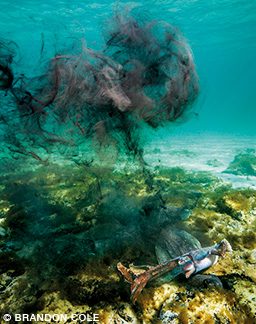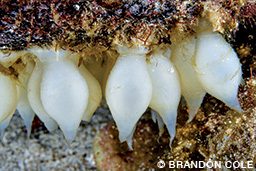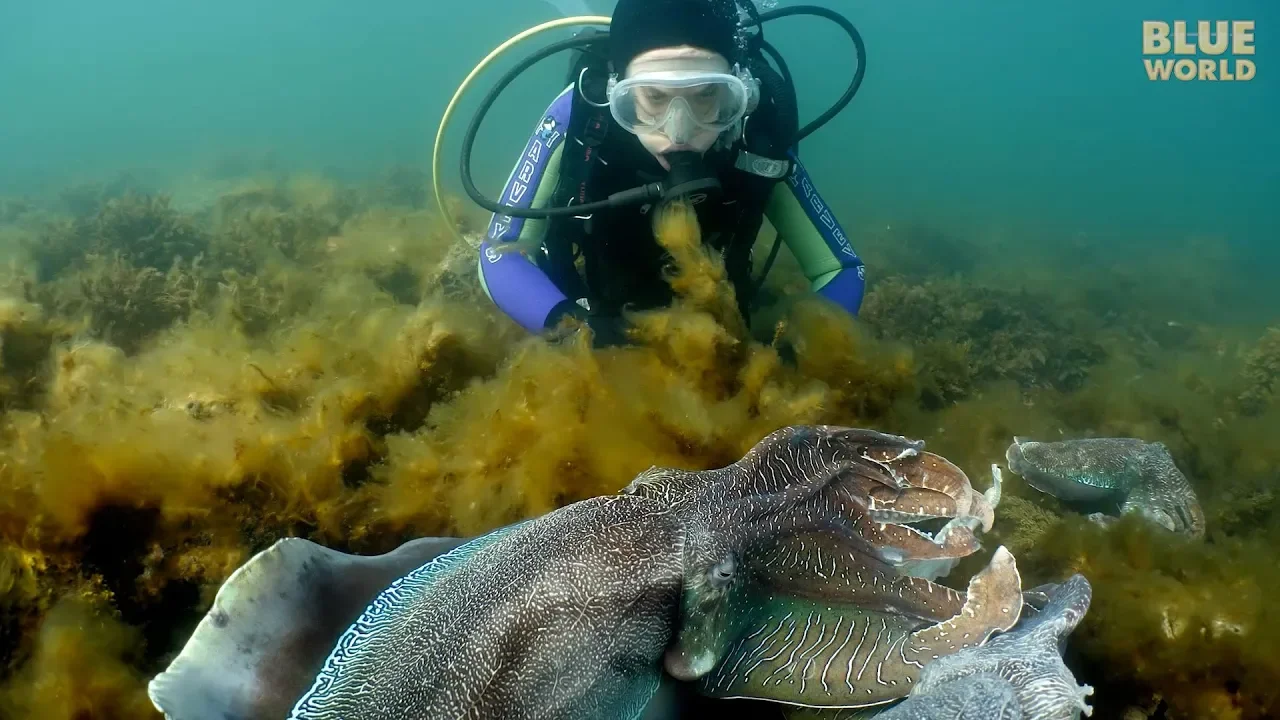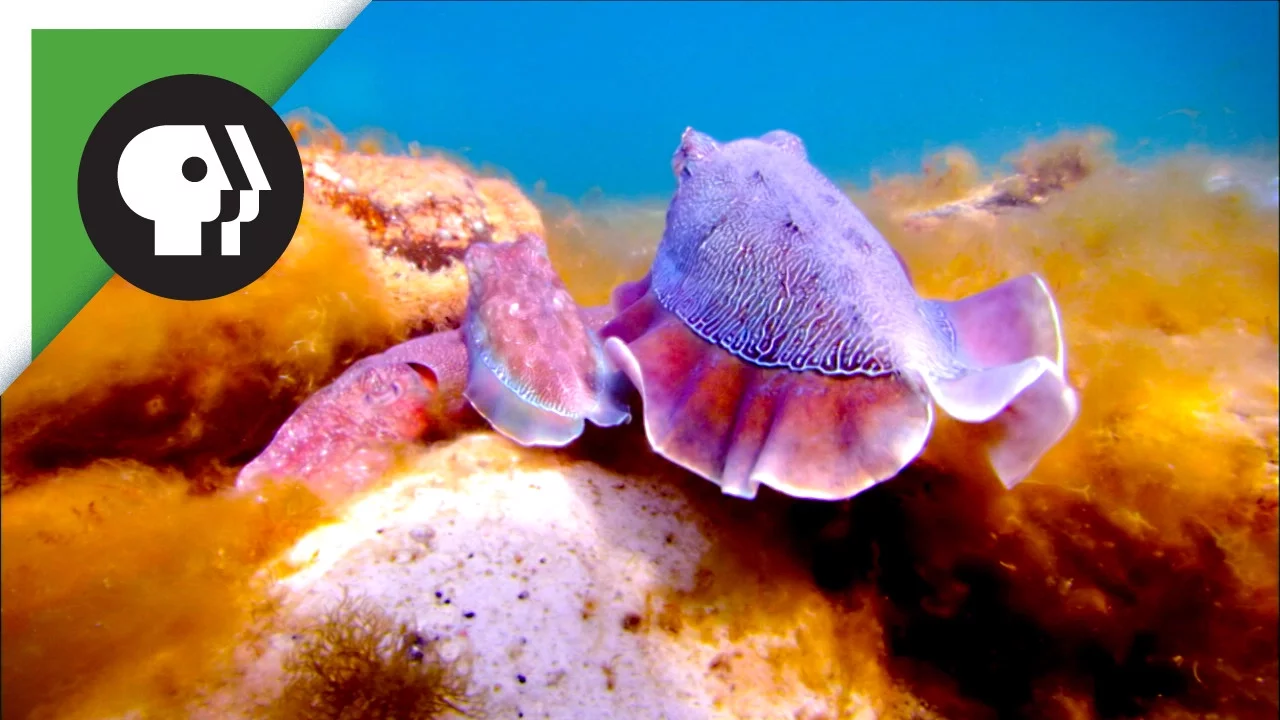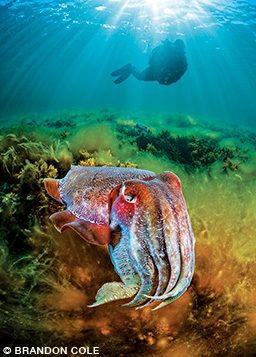
This experience is as close as I’ll ever come to contact with extraterrestrials. Ten feet below the surface off the coast of South Australia, I’m surrounded by dozens of levitating giant Australian cuttlefish. Their annual winter spawning spectacular is in full swing. Technicolor tentacles swirl for a tender cuddle here and a fierce attack there. It’s courtship, combat and mating in all directions. The weird and wonderful behavior on display makes the life-and-death drama of Sepia apama a must-dive natural history event.
Hardly some generic calamari, these are the world’s largest cuttlefish, growing to nearly 3 feet long and a whopping 30 pounds. Along with the other 119 known cuttlefish species in the order Sepiida, Sepia apama shares a molluscan kinship with the other cephalopods: octopuses, squids and nautiloids. It has three hearts, blue-green blood and a doughnut-shaped, super-sized brain, with the largest brain-to-body ratio of all invertebrates. Its 10 appendages — eight arms and two tentacles — are attached directly to its head.
The giant Australian cuttlefish is a living hovercraft sporting a jet propulsion booster, and though spineless, it has perfect buoyancy control thanks to a porous cuttlebone. It can generate an inky smokescreen decoy to escape predators. Its visual sensory system is complex and somewhat like our own, yet different — somehow it can see color in complete darkness, even though we believe it to be colorblind. Its mastery of camouflage is beyond belief. This creature seems to be from another galaxy in terms of biological imagination and sophistication.
Suave Suitors, Valiant Defenders
Much of the year the waters flanking Point Lowly are rather quiet. But as the austral winter draws near, tens of thousands of cuttlefish — more than 100,000 in good years — gather to mate just north of Whyalla in the upper reaches of Spencer Gulf. The flair with which they go about this most necessary business, and the accompanying exquisite color and light shows, must be seen to be believed.
The cuttlefish aggregation runs from late April into August in most years, usually peaking from mid-May through June. Courtship often involves a male adopting the role of attentive guardian and positioning himself next to a smaller female and then advertising ardor by dazzling her with flashing rainbowed colors: neon blue and purple, emerald green, reds, golds and browns. He may also change markings, weaving intricate patterns of dots and lines. The cuttlefish’s skin is both a living canvas and a communication tool. The male may enhance the communication by adding gentle tentacle caresses, but wooing rarely occurs in a vacuum. Males outnumber females on the spawning grounds by as much as 11 to 1, so competition among male cuttlefish can be stiff. I once saw eight males jockeying for position with their envious eyes fixed on the same potential mate.
Most male-versus-male contests involve color wars, invoking chromatic magic meant to intimidate others. They may use scintillating, iridescent hues or blanch completely white. Sometimes there’s a mesmerizing “dark clouds” display, with waves of bold zebra stripes shimmering over their bodies. Males will also flare their arms and inflate themselves or stretch to the limit to prove who is the biggest and baddest. If the posturing fails to demonstrate clear superiority, they may wrestle and fight with strong suckered arms and a sharp beak built for tearing flesh. Most males bear battle scars, and some are missing an arm or two.
Daring Deceivers
Large males have the edge in traditional courtship rituals, but little 12- to 18-inch-long guys can still contribute to the gene pool with some cunning. Their first strategy involves stealth. While the dominant protector is busy grappling with challengers or engaging in ego-inflated color dueling, the nonthreatening, undersized bystander can sneak past the melee of machismo and quickly couple with the lady in waiting. “Sneaker males” can take cleverness to an even higher level to masquerade as an unalluring, unreceptive female by modifying their color, patterning and behavior and hiding the hectocotylus arm that only males possess. I witnessed a daring deceiver casually stroll right past unsuspecting brutes and then copulate with a female. In Darwin’s game, cheating isn’t illegal, and passing on one’s DNA is the measure of success. Biologists believe sneaker males are responsible for more than one-third of all successful mating events.
Color Wizardry
Futuristic biotechnology is at the center of the cuttlefish’s astonishing ability to mimic a clump of algae or hide on the sand in plain sight. Nicknamed “chameleon of the seas,” the cuttlefish’s camouflage ability blows away that of land-based lizards. The secret sauce behind the invisibility skill of Sepia apama is also responsible for its unmatched artistry with color: It’s all in the skin. Millions of minuscule color-changing organs (chromatophores, iridophores and leucophores) are organized into three separate tissue layers and networked by a spiderweb of muscles and nerves. Overseeing control of everything is the cuttlefish’s big brain.
Chromatophores are pigment-filled saccule cells that express varying amounts of red, yellow, brown, black and orange. They are hardwired directly to the brain for a lightning-quick response, facilitating a color change in 200 milliseconds. Iridophores reflect and refract light, adding metallics (gold, blue, green and silver) to the palette. The deepest layer is the leucophores, which are tasked with drawing, erasing and redrawing the white dots and lines necessary for infinite permutations of pattern and decoration on the cuttlefish’s everchanging skin — much like an organic Etch A Sketch.
Caught in the Act
Fancy painting and cerebral processing power will get you nowhere if you cannot bequeath it to your offspring. The prime directive is always procreation. So how do Whyalla’s cuttlefish do it? Once a male can finally breed, he grabs his prospective partner, mating head to head with arms entwined. The male’s hectocotylus arm hands a sperm packet to the female, but sometimes she will discard one gift for another provided by a more promising mate. From the male perspective, there’s no sure thing. Researchers once observed a female copulating 17 times with eight different males over nine hours.
When satisfied with the genetic material, the female fertilizes her eggs, passing them over the sperm packet one by one and then carefully attaching them to the underside of a suitable rock, where a gluelike secretion holds them in place. She may lay hundreds of the inch-long, teardrop-shaped capsules during the spawning season before leaving. There is no parental care. If the embryos survive, well-developed miniature giant cuttlefish will hatch three to five months later to begin their own colorful lives.
Cuttlefish are semelparous, meaning they enjoy only one breeding season in their short, bright lives. At the ripe old age of one or two, they die after fasting for months (thereby sparing numerous crabs and fish from their previously voracious appetites) and becoming completely spent and exhausted by their reproductive rigors. But their mission has been accomplished.
Why Whyalla?
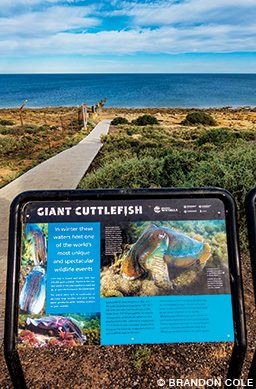
Scientists aren’t certain about precisely where the thousands of cuttlefish come from or why they congregate along this particularly stony shore where the outback meets the sea. A scarcity of suitable egg-laying habitats in Spencer Gulf may be one reason cuttlefish come to Whyalla and more specifically Point Lowly, where orange platelike rocks extend beneath the waterline. These huge sandstone slabs seem to be a perfect substrate for egg attachment. Water depth, salinity and temperature may also be factors.
Stony Point, about a 20-minute drive from Whyalla (where I found accommodations, restaurants and a dive shop), is an ideal spot for divers and snorkelers to experience the cuttlefish aggregation. A ramp gives easy shore access straight into prime spawning grounds hidden from prevailing northerly and northwesterly winds. Visibility varies between 10 and 30 feet (wind from the south or southeast can badly stir up things), and water temperatures are between 50°F and 55°F. The area has tables and restrooms, a covered staging area, and interpretative signage for a quick cuttlefish education. Some people dive other nearby cuttlefish concentrations from shore or via private boat or the occasional charter from Whyalla.
On Decimation and Conservation
Found along the entirety of the continent’s southern coast, giant Australian cuttlefish live a solitary life except for mating time, when groups of up to 10 animals gather — that is, everywhere but Whyalla, where tens of thousands cuttlefish assemble. The astronomical differential speaks to the special nature and acute vulnerability of this area’s spawning grounds. This little stretch of coastline in the upper Spencer Gulf is the only known mass breeding site for Sepia apama.
Many threats loom. The critical spawning habitat’s proximity to the gulf’s numerous oil and gas plants, steelworks and mining operations translates into potential danger from shipping traffic, toxic spills, groundwater contamination and other pollution. There’s also commercial fishing and the Pandora’s box of harmful ocean chemistry changes related to global warming, including warmer water temperatures, supercharged algae growth, and higher carbon dioxide levels that contribute to ocean acidification.
During the past five years the South Australian Research and Development Institute (SARDI) has reported robust Whyalla spawning populations between approximately 125,000 and 177,000 animals. But it hasn’t always been that way. Twenty-five years ago, commercial fishing of this aggregation decimated the population, with numbers crashing from an estimated 200,000 animals down to a few thousand. Since then, government closures on harvesting have helped the population rebound, albeit sporadically.
Tentacles crossed that this charismatic cephalopod species remains protected into the future, allowing them to procreate in peace with their internal disco lights flashing in time to their otherworldly rhythms of romance.
Explore More
Watch giant Australian cuttlefish in action in these videos, and then view a photo gallery of other critters from southern Australia.
© Alert Diver — Q2 2020
